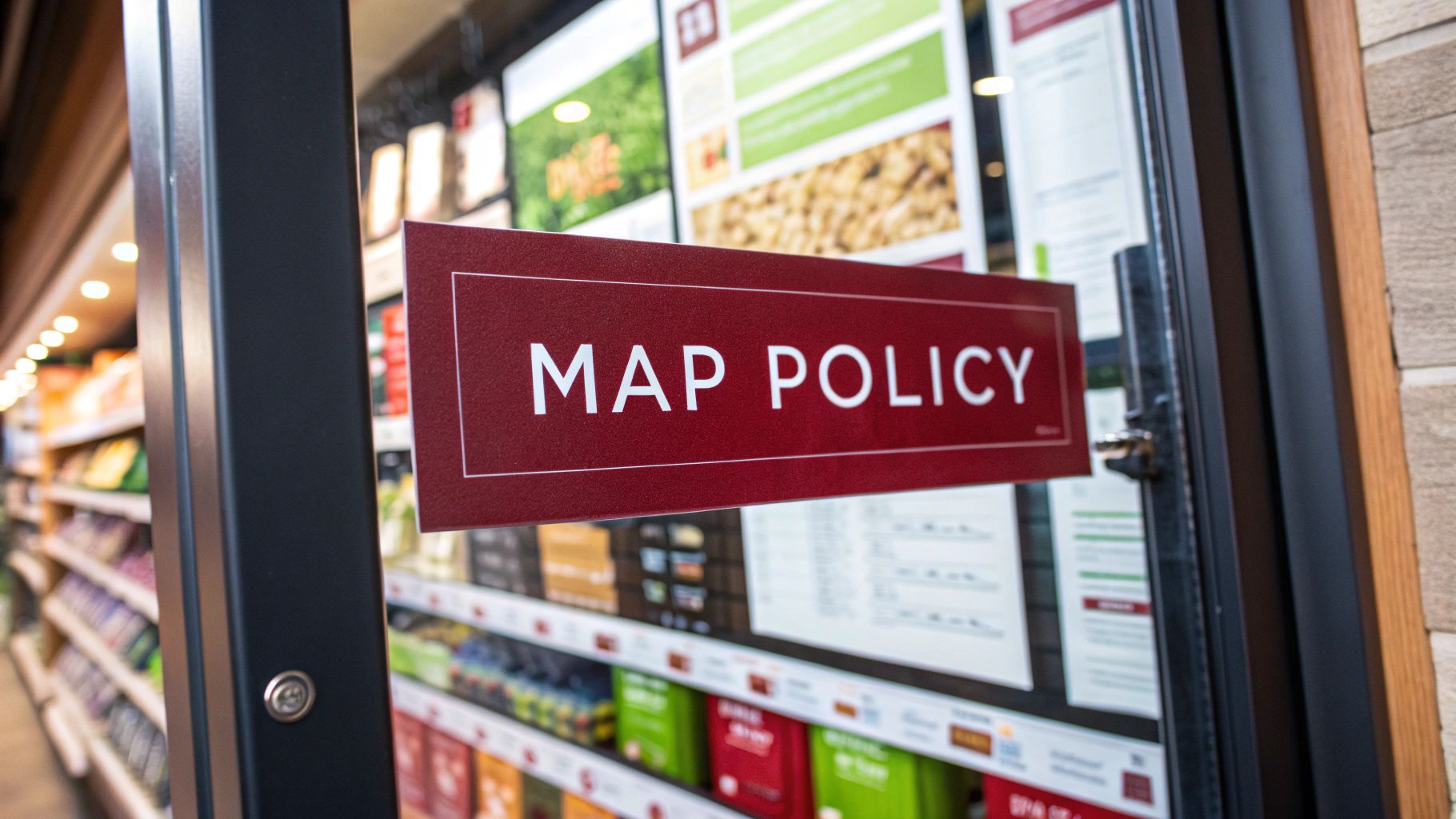You might build a great product line and an impressive brand following, but if one retailer sells it for half the price of another, customers start questioning your brand’s value not the seller’s.
That’s why successful companies rely on two pricing principles that protect their reputation and profits: MAP (Minimum Advertised Price) and MSRP (Manufacturer’s Suggested Retail Price).
They are the framework that helps brands protect their value, prevent price wars, and keep every reseller aligned.
Why Pricing Strategy Defines Brand Success

In the past few years, especially with the explosion of third-party sellers on Amazon and Walmart Marketplace, many brands have seen their prices spiral downward without control. One unauthorized seller drops the price to win the Buy Box, another follows, and within days, a premium product looks like a bargain-bin item. The result? Your brand reputation and reseller relationships take a hit.
Imagine you see a product for $100 on one site and the exact same item for $45 on another. Does that signal a great deal? Not really. It signals chaos and suggests the brand has lost control.
The uncontrolled discounting vaporizes your profit margins and guts the margins of your retail partners. Soon, they have no incentive to market your products or offer good customer service.
Uncontrolled discounting is one of the fastest ways to devalue a product. It trains customers to wait for a sale, killing full-price demand and destroying your brand’s perceived worth.
Failing to establish a clear pricing strategy creates serious long-term problems. In fact, there are at least five brand consequences of heavy discounting, and each one can cause significant damage.
What Is MAP Pricing (Minimum Advertised Price)?
A Minimum Advertised Pricing (MAP) policy sets the lowest price a retailer can publicly display for your product. The key word here is advertised. It doesn’t control the final selling price, just what appears in ads, on website listings, or anywhere else the public can see.
For private label brands on Amazon, a MAP policy is a must-have. It levels the playing field among dozens or hundreds of third-party sellers. If you’re building a brand, a solid MAP policy is a foundational piece you need from day one.
For example, a premium coffee maker brand sets a MAP price of $199. A retailer can sell it for $180, but they cannot show any price below $199 on their product page. A common and compliant workaround is to reveal the lower price only once the item is in the shopping cart.
What Is MAP (Minimum Advertised Price) Policy?

A Minimum Advertised Price (MAP) policy is a “public price floor” a brand sets for its products. It’s the lowest price a retailer is allowed to advertise publicly.
Here’s the most common misunderstanding: MAP does not control the final sale price. A retailer can sell a product for less than MAP, but they can’t show that lower price on a product listing or in an ad until a customer takes an action (like adding it to their cart). That distinction is critical.
A minimum advertised pricing policy is a strategic tool that protects a brand and its entire retail network. Without one, you’re inviting a price war that erodes profits and cheapens your brand’s image.
Purpose of a MAP Policy
Why do brands implement a minimum advertised policy? It comes down to three goals:
- Protects Brand Value: Consistent pricing reinforces that your product is worth its cost. Constant, steep discounts signal low quality. MAP helps maintain the perception of value.
- Maintains Fair Competition: MAP levels the playing field. It stops a massive online retailer from advertising rock-bottom prices that a smaller shop can’t match, giving all authorized sellers a fair chance.
- Preserves Profit Margins: When sellers aren’t in a constant battle to undercut each other, both they and the brand maintain healthier profit margins. That money can be reinvested into better marketing and customer service.
MAP ≠ Selling Price
It’s worth repeating: a MAP policy governs the advertised price, not the final transaction price.
A retailer can sell a product for less than MAP as long as that lower price isn’t displayed publicly. The “add to cart to see price” feature is a common and legal workaround. It respects the brand’s public pricing while giving the retailer flexibility to offer a better final price to a serious buyer.
This is a key component of many effective Amazon pricing strategies, allowing sellers to compete for the sale without starting a public price war that hurts the brand.
How MAP Policies Are Created
A Minimum Advertised Pricing (MAP) policy is a simple set of rules that helps you protect your brand’s pricing and reputation. Many sellers skip this step until they see their product listed cheaper by someone they’ve never supplied. By then, it’s already hurting their sales and image.
Your policy document must be crystal clear. Using a legal resource like a Terms and Conditions Template can provide a solid framework.
Here’s how smart brands build a MAP policy that actually works.
1. Know Why You Need It
Before you write a policy, get clear on what you’re trying to fix.
For most brands, the problem is price undercutting.
A MAP policy is meant to stop that before price war starts among sellers. It’s not about controlling sellers. It’s about keeping everyone honest and protecting your brand’s value.
2. Decide What Products It Covers
You don’t need to include every SKU. Start with your main products or the ones where pricing problems keep happening. Make a list that shows:
- Product names or SKUs covered
- The minimum advertised price for each
- Where the rule applies (Amazon listings, ads, Google shipping, social media, etc.)
Review this list a few times a year. Prices change. You may launch new items or stop selling others. Keeping the policy updated helps you avoid confusion with resellers.
3. Make It a One-Way Policy, Not an Agreement
In the U.S., a MAP policy must be unilateral, which means it’s your rule, not a mutual agreement. You’re not asking sellers to sign anything or “agree” to the price. You’re telling them the standard your brand follows and what happens if they break it.
The legal principle behind this is called the Colgate Doctrine. It basically says a brand can choose who it sells to, as long as it’s done independently and fairly.
Here’s the right way to word it:
“Our company may stop supplying any reseller that advertises below the listed MAP price.”
And here’s what not to write:
“Retailers agree not to advertise below MAP.”
That one word “agree” can make your policy look like a price-fixing agreement, which isn’t allowed.
4. Be Clear About the Consequences
A MAP policy means nothing if there are no consequences. You need to spell out what happens when someone violates it. What matters most is consistency. Treat every reseller the same way. If you punish one and ignore another, it creates problems fast.
5. Communicate With Your Sellers
Most MAP problems happen because sellers don’t understand the rules. Don’t just send a long document. Explain it in plain language.
You can:
- Add a one-page summary that lists what counts as a violation.
- Hold a short training call or video demo for your key resellers.
- Include a reminder in your wholesale onboarding materials.
When sellers understand the “why” behind the policy, they’re more likely to respect it.
6. Track and Review Regularly
Once the policy is live, track it. Keep a record of who received it, who broke it, and what actions were taken. This protects you if someone complains or tries to argue about fairness.
Check your pricing every few weeks. You can use tools like PriceSpider or TrackStreet, or even set up Google alerts for your main product SKUs. Regular monitoring keeps everyone accountable and stops issues from growing.
How MAP Policies Are Enforced

So, you know a minimum advertised pricing policy is essential. But how do you create one that works and can be enforced legally?
It’s not as simple as sending an email with a new price list. A real MAP policy is a formal, unilateral declaration from the brand laying down the rules.
A policy is useless without enforcement. Manually checking hundreds of listings every day is impossible. This is where technology helps.
1. Monitoring Methods
Automated price-tracking tools are your best friends. Software like PriceSpider or TrackStreet scans the internet, including major marketplaces, and flags listings that drop below your MAP pricing. They capture screenshots and timestamps, giving you the evidence needed for action.
However, don’t rely on software alone. Periodic manual audits are smart to catch anything that slips through. A mix of automated monitoring and manual checks creates a strong enforcement system.
Your ability to enforce your MAP policy consistently and fairly is what gives it real authority. If you let one retailer slide, you undermine the entire structure.
2. Confirm the Violation Before Acting
Not every low price is a real violation. Always double-check before sending a warning.
For example:
- If a seller shows a price lower than MAP but applies a coupon at checkout, that’s fine. MAP covers advertised prices, not private discounts.
- If the product is part of a bundle, check if the value matches MAP when combined with other items.
- If the listing is outdated or duplicated, the seller may not even know it’s still active.
Take a screenshot or record the listing with a timestamp. You’ll need proof if a seller argues.
3. Follow a Clear Warning Process
Once you confirm a violation, contact the seller directly and professionally. Be polite but firm.
A good process looks like this:
- First violation: Send a warning email. Explain what’s wrong and ask for correction within 48 hours.
- Second violation: Pause supply or remove them from your authorized reseller list temporarily.
- Third violation: End the relationship completely.
Avoid long arguments or debates about your policy. You’re not negotiating but enforcing the rule you already set.
Keep records of every email or notice you send. This shows consistency if you ever face legal or brand disputes.
4. Stay Fair and Consistent
The quickest way to lose control of your pricing is to treat sellers differently. If you warn one but ignore another, word spreads.
Every seller, no matter how big or small, should face the same actions for breaking MAP.
This builds trust with your compliant sellers. They’ll see you as a brand that stands behind its policy, not one that plays favorites.
5. Deal With Unauthorized Sellers
Unauthorized sellers are a major problem on Amazon. Many get products through liquidation, wholesale leaks, or overseas distributors. They often ignore MAP completely.
Here’s what you can do:
- Use Amazon Brand Registry and report sellers violating your MAP or trademark rights.
- Include a “no third-party reselling” clause in your wholesale contracts.
- Consider using Amazon’s brand gating option to fully protect your products.
- Track your inventory sources to find out where unauthorized sellers are getting your stock.Our guide on Amazon brand gating features a section that explains how to identify rouge distributors. Be sure to take a look!
If you can’t remove them right away, focus on tightening your authorized channels. The fewer leaks, the easier it is to control your pricing.
6. Regional Differences in Enforcement
Pricing rules aren’t the same everywhere. A policy that’s legal in the U.S. could get you in trouble in Europe.
- United States (U.S.): MAP policies are legal if they are unilateral (Colgate Doctrine). Retailers can choose to comply but risk losing their authorized status if they don’t. Enforcement must be consistent.
- European Union (EU) & United Kingdom (UK): MAP and similar minimum price policies are largely restricted or illegal. They are considered resale price maintenance (RPM) under competition law. Brands use Recommended Retail Prices (RRP) instead.
- Online Marketplaces (Amazon, eBay, etc.): Marketplaces do not enforce MAP policies for brands. The responsibility lies solely with the manufacturer. Brands must track and address violations directly.
What Is MSRP (Manufacturer’s Suggested Retail Price)?
MSRP, often called the “sticker price,” is the price a manufacturer recommends a retailer sell a product for. Unlike MAP, MSRP is just a suggestion, not a rule.
Its main purpose is to act as a value anchor for customers. It gives them a benchmark to judge a product’s worth, which is why you see sales framed as “20% off MSRP!”
How MSRP Helps Brands and Sellers
MSRP is useful for both brands and retailers, even though it’s not mandatory. Here’s why it still matters:
- Sets a value anchor
When shoppers see a higher “regular” price and a discount below it, they can quickly judge the value of the offer. MSRP makes that comparison easy. - Keeps prices consistent across stores
Even though sellers can charge what they want, having a standard suggested price makes the market feel more stable. It prevents extreme price differences that confuse customers. - Supports premium positioning
High-end brands often use MSRP to signal quality. If every competitor’s product sells around $50 but your MSRP is $89, it helps customers understand that yours is a higher-end choice. - Simplifies promotions
Retailers often advertise discounts like “25% off MSRP.” It’s a simple, honest way to show savings without breaking MAP rules.
MAP vs MSRP Pricing
MSRP and MAP work together, but they serve different purposes. Let’s break down the key differences between MAP pricing and MSRP pricing.
1. Advertisement vs. Sale
- MAP governs advertised prices (the lowest price you can publicly display).
- MSRP defines suggested selling prices (what the brand recommends charging).
MAP controls price visibility; MSRP guides price positioning.
2. Mandatory vs. Voluntary
- MAP policies are mandatory. Violations lead to penalties like warnings, suspension, or termination.
- MSRP is voluntary. There are no formal penalties, but not following it can hurt your relationship with the brand.
3. Price Floor vs. Price Benchmark
- MAP acts as a price floor in advertisements to prevent devaluation.
- MSRP serves as a benchmark or reference price for value perception.
A strong MAP policy helps maintain MSRP’s credibility by ensuring public prices don’t drop too low.
4. Retailer Flexibility
- Retailers can sell below MAP privately, as long as it’s not publicly advertised.
- Retailers can sell above MSRP freely, especially during high demand.
Both policies must be unilateral manufacturer rules to remain legally compliant.
5. How MSRP and MAP Work Together
These two policies work as a team. MSRP establishes a product’s value, and MAP enforces minimum advertised pricing to protect that value.
Combined, they:
- Protect brand reputation.
- Prevent destructive discounting.
- Maintain fair competition across sellers.
This is vital for covering business costs, including the various Amazon fees for sellers.
MAP & MSRP Best Practices for E-Commerce Sellers
- Always review supplier MAP/MSRP policies before listing. For example, if a supplier’s MAP for a blender is $99, don’t list it for $98.99.
- Never advertise below MAP. If you want to offer a discount, use private coupons or a “see price in cart” feature.
- Use monitoring tools like PriceSpider or TrackStreet to track your own compliance and competitors.
- Communicate with brands transparently. If market conditions require pricing adjustments, have a conversation with your supplier.
- Align promotions with MSRP to build trust. A “20% off MSRP” sale feels more legitimate than a random discount.
Q&A Section
How do you enforce MAP price violations?
Follow a consistent, three-step process:
- Written Warning: Send a formal notice with evidence and a 24-48 hour deadline to comply.
- Temporary Suspension: If ignored, suspend their account or shipments for a set period (e.g., 30 days).
- Permanent Termination: For repeat offenders, revoke their authorized retailer status for good.
What is MAP monitoring & MAP monitoring software?
MAP monitoring is the process of scanning the web for retailers advertising below your minimum advertised price. MAP monitoring software (like MAPP Trap) automates this by crawling websites and marketplaces, capturing evidence, and sending alerts.
How to enforce MAP pricing on Amazon?
Amazon will not enforce your policy for you. The responsibility is 100% yours. You must:
- Identify the third-party seller.
- Contact them directly with a warning notice referencing your policy.
- If they are an authorized retailer and don’t comply, follow your penalty ladder, which may mean cutting off their supply.
- If this does not work, consider Amazon brand gating.
Is MAP pricing legal everywhere?
No. It’s generally legal in the U.S. if it’s a unilateral policy. However, it’s largely illegal in the EU, UK, Canada, and Australia, where it’s considered resale price maintenance. Always consult with local legal counsel when selling globally on Amazon.
Can I sell below minimum advertised pricing (MAP) privately?
Yes. The policy applies to publicly advertised prices. A lower price revealed in a shopping cart, via email quote, or over the phone is typically compliant.
What happens if I break a MAP policy?
Consequences range from a formal warning to having your shipments suspended or your authorized retailer status permanently terminated.
Do MAP and MSRP apply to all product types?
No, they are most common for branded goods in competitive categories like electronics, appliances, and high-end consumer products where brand value is critical.
How do I report competitors violating MAP?
Report them directly to the brand or manufacturer, not the marketplace. Provide screenshots and links as evidence. The brand is responsible for investigating and enforcing their own policy.





